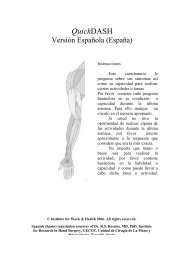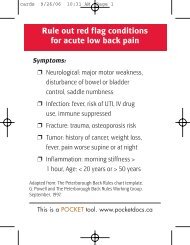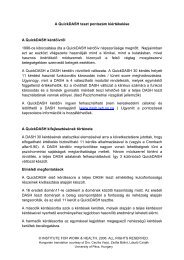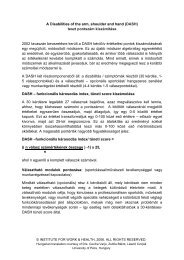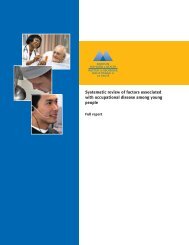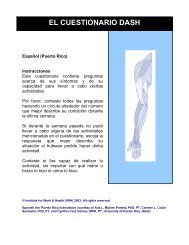A systematic review of injury/illness prevention and loss control ...
A systematic review of injury/illness prevention and loss control ...
A systematic review of injury/illness prevention and loss control ...
- No tags were found...
Create successful ePaper yourself
Turn your PDF publications into a flip-book with our unique Google optimized e-Paper software.
16. Indicate the time period between the baseline measurement <strong>and</strong> all subsequentfollow up measurements. Use months to indicate the length <strong>of</strong> follow up, for example,questionnaires were administered at 6, 12, <strong>and</strong> 18 months. Indicate in months if possible, ifnot in weeks, days etc. or enter “NP”. Please make sure that you describe all interventiongroups <strong>and</strong> all referent groups using the same group notation throughout the data extractionforms.E.g., Baseline data collected on May 1st, 2000. Intervention implemented June 1st, 2000continues until June 1 st , 2001. Follow-up data collected on May 1 st , 2002. Note thisinformation may be presented in a number <strong>of</strong> ways (tables, figures, timelines etc). In thisexample, the length <strong>of</strong> follow-up is I 1 =24 months.Often in administrative data there are not multiple time points <strong>of</strong> outcome data collection.Instead there are time periods over which data are collected. For “administrative” data, it isbest to establish what the intervention period is first. Then establish the baseline data periodfor outcome measurements. This period may be a month, 6 months, or years before theintervention. State the full time-period for which baseline outcome data was collected (e.g.,“data was collected 3 years prior to lifts installation” answer: April 1998 to April 2002).Finally, establish the follow-up period (e.g., “We compared to 3 years after the lifts werecompleted installation” answer: July 2002 to July 2005).Study Group Questions:17. Describe overall (study) group. Intervention(s) + Control(s)Sample SizeAge (mean, SD, range)% femaleLoss to Follow up (N)18. Describe the Intervention group(s). Provide answer(s) for each category - enter “NP” inall comment boxes where information is not available. If design is cross-over then answer forI 1 C only.*Use notation (I 1 , I 2 , <strong>and</strong> I 1 C)Sample Size Eg: I 1 =, I 2 =, … (or I 1 C= )Age (mean, SD, range) Eg: I 1 =, I 2 =, … (or I 1 C= )% female Eg: I 1 =, I 2 =, … (or I 1 C= )Loss to Follow up (N) Eg: I 1 =, I 2 =, …(or I 1 C= )Time Period <strong>of</strong> Measurements (start date to end date)19. Describe the Referent group. Provide answer(s) for each category - enter “NP” in allcomment boxes where information is not available. If design is cross-over then answer forI 2 C only.*Use notation (C, I 1 C, <strong>and</strong> I 2 C).78 Institute for Work & Health



